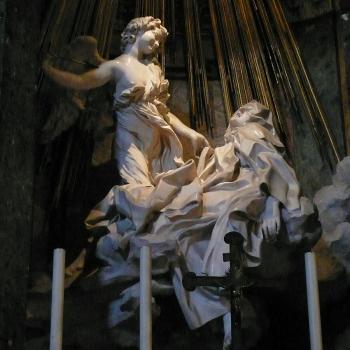Two of them are good. One of them is not good! …Plus bonus Pope Emeritus at the end.
When I learned that Netflix had made a series about a 14th-century Spanish serf who takes part in the building of a Barcelona church, I was all about that. When I learned there was a book, I grabbed that book with a swiftness. Cathedral of the Sea, by Ildefonso Falcones, was a bestseller in Spain; and oh how I wanted it to be great!
Instead it is a tendentious bodice-ripper in which caricature people act out the proposition that Christianity makes people evil. Also, killing Jews is evil (yes, good, keep going), raping peasant women is evil (yes, I’m here, go on), but slavery is just one of those things, the heroes pretty much all own slaves, and the only heroic slave is the loyal one who would do anything for his owners because they are so ethical. I would say this character is “the only fully-drawn enslaved character” but none of the characters are fully-drawn. Cathedral is one of those books where Mary is good but Jesus is absent, which I could find poignant if it were not, again, so table-poundingly tendentious. It takes a lot to make me really loathe your medieval peasant’s-eye Jew-lovin’ cathedral-glorification tale, and yet here we are. I threw this book away instead of taking it to the used bookstore. I apologize to any raccoons who read it.
After that I read Andrzej Szczypiorski’s A Mass for Arras, a short, bizarre fictional account of a pogrom in 1461. The pogrom takes place after plague, as in Cathedral, and its violence spills out into the gentile community, for which it’s hard to be sorry. Szczypiorski took part in the Warsaw Uprising and survived a concentration camp. So it shouldn’t be surprising that several of the most powerful sections of the book concern the ways suffering changes people: the chasm between those who have undergone extreme and prolonged suffering, and those who haven’t.
There are philosophical and religious debates in this book, and stances are taken, but these stances were often baffling and contradictory. There are thickets of (seeming? intentional?) non sequiturs. These disjunctions contribute to the book’s overall Boschian, purgatorial atmosphere, a world of distortion and absurdity, of punitive carousing and sincere hypocrisy. The town of Arras is the center of the tale: Like ‘Salem’s Lot (sure, let’s do this comparison) it’s about how small towns shape their inhabitants’ souls. It’s the town as beloved, as faithless lover, as family, as replacement god. The main character, Jan, was an outsider to Arras and is telling his tale from the refuge he’s taken in Bruges, and yet every page is tinged with the blood of the town, the harrowed soul of Arras.
It’s hard to quote from this book, since its powerful passages often build slowly. But this is a sample:
Good sirs! Now prick up your ears. What does your city mean to you? Is it something you dream about at night? When one of you dreams of Bruges, you hear the creaking ropes of your ships, smell seaweed and fish. Nimble gulls fly over roofs, hustle and bustle everywhere, endless pursuit. Bruges is like a bird, while Arras is like a tree. There, each person feels the roots of that tree in his very depths, just as here each person feels the lightness and freedom of a bird in passage.
[there follows a strange argument between God, Jan, and the Devil, in which Jan asks like Pilate, “What is truth?” and God replies:]
“I commanded Abraham to go out of Ur and abandon his own town, so not to have any desire but the desire for God. I tore Abraham’s roots from his own soil, so that he would have no other soil but the soil of God.”
What does that mean? I thought, beating my forehead against the cool stone floor.
Then I heard the Devil whisper, “Jan! Settle in a town whose name is Jan.”
And while Jan is having this conversation in the local church, outside the citizens of Arras are slaughtering one another.
A Mass for Arras has an alien quality which can make it hard to find a toehold. But that alien quality is maybe part of the point: I’m one of the citizens of Bruges, hearing this tale from one whose life has taken a turn I can’t understand.
A simpler book, more flawed but quite memorable, is Gene Luen Yang’s graphic novel, Boxers & Saints. This is a two-volume cartoon about the Boxer Rebellion: one volume for Little Bao, a boy who decides to fight alongside the Society of the Righteous and Harmonious Fist to save China from the “foreign devils” and their “secondary devils” the Chinese Christians; and one volume for Four-Girl/Vibiana, a “secondary devil” with visions of St. Joan of Arc.
The art is simple and pleasant, maybe erring on the side of cute; there’s a flat beige-y palette except when the characters are having visions, which sounds good in the abstract but made the book harder for me to read. Yang has a hard time with action sequences–I often wouldn’t have known what was happening without action-captions like DUCK! or SWIPE! This is kind of a problem when your whole book is about war.
And the metaphysics is weird: It seems like both the traditional Chinese religion and Joan’s Christianity are true. That’s the most visually-striking choice (the scenes involving “the gods of the opera” are among the book’s strongest images) but I admit I prefer when your metaphysics makes what the philosophers call “sense.” (I know I praised Arras for its absurdity but the book was about that absurdity, which this one isn’t.)
That said, the characters and their interactions are what make this story work. Little Bao is a true believer, who joins the Boxers because of real harms done by the Christians–you can believe alongside him. Vibiana has a much more… complex? ambivalent? totally whackadoo? relationship with Christianity, which makes the book’s final imagery and plot twists all the more powerful. Seriously, the ending of this duology is fantastic: heartfelt, deeply Christian, unexpected, an overturning of all the world teaches us to expect. This is an intensely Christian book precisely because none of its characters are “good Christians.” It’s an expression of a belief system without being propaganda for it.
A little while before I finished Arras and Boxers, I read Pope Benedict XVI’s Jesus of Nazareth: The Infancy Narratives. I loved this little book (I underlined like half of it) but perhaps the thing that struck me the most is the way Benedict (or his translator?) consistently uses “promise” where I think most writers would say “prophecy.” Jesus fulfills, again and again, the promises God made as recorded in the Hebrew Bible.
This is very hard to believe, you know. I mean look around you. Do you feel that the promises have been fulfilled?
I’m about to head out to Confession, and then Mass. I’ll be there when eternity enters into time, when Calvary comes again. I will accept that Jesus’ life and death changed something, that in Him our hopes and God’s promises are truly fulfilled: that the door is open now to forgiveness of sins and liberation into a new way of life. But it is not so easy to see.
Suddenly it occurred to me that to explain in the fairest way what had happened here, I should begin with the creation of the world.
–A Mass for Arras











